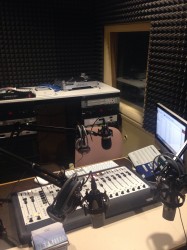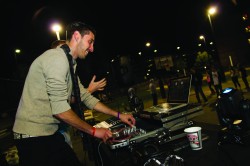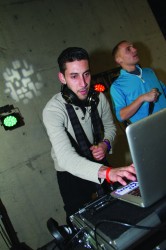By CANDACE MITCHELL

WRPR-FM, the official radio station licensed to Ramapo, has been out of action for over a year due to construction on campus.
The FM frequency of the student-run college radio station was disabled when construction began on the G-wing in June 2013, leaving the students without the ability to continue their live broadcasting.
“Both the cables that connect WRPR to the antenna and the antenna itself, which is housed on the roof of G-wing, were impacted by the work involved in renovating G-Wing,” said Eddie Seavers, associate director of the Center for Student Involvement, in an email.
At about the same time, the WRPR studio underwent a renovation: new paint, carpet and studio equipment. However, the new studio equipment was not set up properly, causing them to lose their online feed as well.
“The online broadcast was impacted by a variety of things, including work done to update parts of the student center, as well as new equipment,” Seavers said in an email. “Resetting the internet broadcast has proved to be more challenging than anticipated based on updated technology and has involved a variety of elements related to ‘hosting the site’ and more.”
“Between the maintenance crew here at Ramapo and the outside maintenance crew that we hired to come in and oversee studio equipment … they haven’t been on the same wavelength in a year,” said John Dinunzio, a senior and studio manager at WRPR. “So there’s been confusion there, but we’re hopefully getting an online feed within the next month.”
This series of events resulted in Ramapo’s college radio station not having the ability to broadcast live, something they had been doing 18 hours a day, or 126 hours a week, prior to the loss of FM and online frequency. Many of the students were left wondering what to do next.
“The person that always did the studio stuff … had no idea what to do,” said Philip Rocha, a junior and live manager at WRPR. “They were like what am I supposed to do because now I am in this position [studio manager] and it’s gone. Some people in the club are a little bit discouraged … or they don’t go to all the meetings because they’re waiting on the studio.”
However, other members of the organization are making an effort to keep the radio station’s presence alive on campus.
“But what we’re doing right now, even the studio manager, we’re just working together to do live events, and it’s easier too. I mean the titles that we have, live and studio manager, they’re just loose because we just do everything together because I feel like that’s how most things get done,” said Rocha. “If we work together as leaders then it works out and it helps everyone in the club be more engaged.”
Past Broadcasts
Before the FM frequency was disabled, WRPR had been broadcasting live from Ramapo College since the early 1970’s. The radio station involved and promoted the work and activities of the school and students, including sports teams, musicians and campus news and opinions.
The radio station featured student-run programs and talk shows on various topics, most shows were featured regularly on certain days and times.
“There were people with shows and they had time slots,” said Rocha. “It was bigger probably like three years ago. If you look at the plaques outside … where they have the best club of the year, those years was when they had more of the studio thing going and people had shows. They could do sports, or anything they want really, anything they wanted to broadcast as long as they followed the FCC rules.”
Dinunzio was one of those students who had his own talk show during his early days at WRPR.
“I had a radio show with my buddy, so really we would just use it to promote students on campus that played music and we would play that,” said Dinunzio. “Really anyone could have their own radio show and play whatever they wanted.”
Dinunzio cited promoting the music of student and local musicians as what he considers to be one of the most important features of WRPR and college radio stations in general.
“We would get CDs from outside, independent artists in the area and students,” said Dinunzio. “If the radio was up right now that’s what I would be doing, promoting. That’s the whole point of college radio is to promote student music or any music that’s around the area.”
WRPR also featured live broadcasting for all the sports, as well as updated news on campus, Dinunzio added.
Listen to John Denunzio talk about the radio show he used to host:
Disabling 90.3 FM
When the FM frequency was originally disrupted in the summer of 2013, the students thought the problem was a quick fix.
“We thought it was going to be quick,” said Dinunzio, laughing. “We thought it was going to be right back up, but it wasn’t.”
However, the College has not yet been able to complete the steps to restore WRPR’s FM frequency.
“The lines need to be re-run and the antenna needs to be reset, although in reviewing the process to set everything back up, there have been discussions about rerouting the connection to help avoid future issues,” said Seavers in an email. “The cost of the project isn’t known yet as it involves an outside company.”
At the beginning of the 2013 fall semester the members of WRPR discussed the problem in a meeting, and over a year later the problem has continued on through two different managers, beginning with former general manager Craig Homa, and now falling on the shoulders of current studio manager, John Dinunzio.
“We had a meeting and I wasn’t manager at the time, it was Craig who was manager at the time. And we had a meeting and he said ‘our antennas got taken down due to construction and they were put back up improperly and it’s going to cost a lot of money to fix.’ So they were trying to work on it and then it never got fixed,” Dinunzio explained. “And now it’s on me. And I’m just looking forward to getting the online back.”
In fact, some members of the organization, including the live manager, were not very involved in the organization the last time it had a working FM frequency, making it difficult for them to fill in all the blanks of what went wrong and why the problem is not resolved.
“I wasn’t as engaged in the club when we had the studio thing … The school keeps telling us that it’s the construction of the nursing building because they kind of ripped the antenna out or something like that,” said Rocha. “I don’t know the whole details … I forget it’s been so long.”
Listen to Philip Rocha describe WRPR’s yearlong struggle to get their radio station back up and running:
Live Events
Without an FM frequency or online feed, WRPR is forced to turn their attention elsewhere.

“As of now we compensate for that with live events that we do. We help every club on campus, every sorority, if they need it, every frat,” said Rocha. “Each one is for a different cause, for a different reason, for a different show.”
WRPR teams up with other organizations to set up sound or DJ their live events. The radio station also held their first solo live event in October, featuring DJ Sunsett, a senior at Ramapo. The organization hopes these types of events will help them keep a presence on campus.
“We haven’t died out,” said Dinunzio. “We could have died out because we didn’t have radio feed and that is out of my control. I focus a lot of attention on live events. So we’re still out there and we’re still doing our live events that we used to just do every once in a while, maybe once a month, but now we’re doing like three events a week.”
Live manager Philip Rocha cites this as one of the few positives to come out of this yearlong ordeal.

“People can come to more things,” said Rocha. “And it made us think of alternatives about how we’re going to expand the club and make up for it, which is like critical thinking I guess about how we’re going to make ourselves a big deal again.”
The Future
WRPR is currently maintaining a tight schedule with students recording their radio shows during their predetermined time slots, and following the FCC rules for a live broadcast. The only catch is: they’re not live, or on the air.
The Center for Student Involvement is working with WRPR as well as other offices on campus and outside engineers in the hopes of restoring both the FM and online frequencies.
“CSI works with an outside radio engineer to act as our liaison as no one in our office has the technical proficiency to run a radio station. We serve as a liaison between this engineer and the various offices on campus who have elements required to get both internet broadcasting and FM broadcasting functioning,” Seavers explained in an email.
The timeline for getting WRPR’s FM frequency back up and running is undetermined.
“They tell us some things,” said Rocha. “They told us last year that there was multiple check points … ‘November, December, oh by next year.’ And then nothing. It’s probably not a priority, but it is a priority because the school has a license to stream radio. They have the license to broadcast. They need to utilize that because they do pay for it. It’s out of my hands like I can’t do anything about it.”
However, WRPR expects to get their online stream up and running by next semester since the repairs are less costly and extensive than those required to restore the FM frequency.
“The cost on this is minimal, especially compared to the FM Broadcast, but is impacted more by determining the best technology pieces going forward as what was there was outdated,” Seavers said in an email. “Online will happen first and will hopefully be functioning when the spring semester starts. I don’t have an exact timeline on FM as it is still impacted by work ongoing in G-wing, but we’ve made good progress this semester.”
[SOUNDSLIDES: Listen to an explanation as to why WRPR is no longer on the air.]
Leave a Reply
You must be logged in to post a comment.